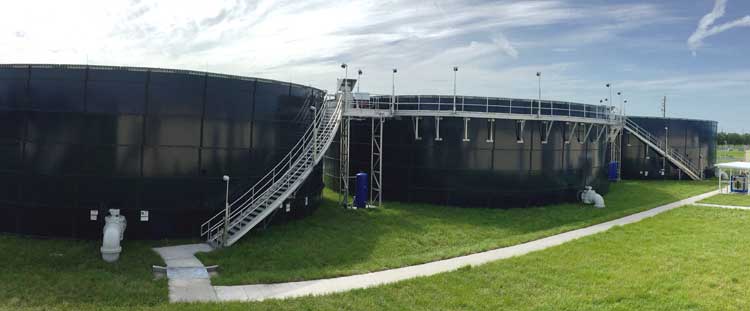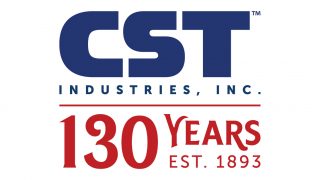
Published in the June 2019 issue of WaterWorld Magazine
Situated about 45 miles southwest of Tampa, Manatee County’s lush environment needs water to thrive, and prudent management of that water is essential. Officials take water management seriously, including the methods used to recycle wastewater for irrigation and other non-potable uses.
The County’s 5,300 reclaimed water customers include golf courses, parks and playgrounds, landscape areas, highway medians and rights-of-way, and farms. Other uses include toilet flushing and fire protection. About 62 percent of the wastewater generated in the County is reused in the reclaimed water system.
Manatee County has three water reclamation facilities that can operate at a combined capacity of up to 33.5 million gallons per day. The reclaimed water distribution system consists of approximately 943,276 linear feet (179 miles) of County-owned transmission mains, two booster pump stations, and one re-pump station. A 30-inch transmission main interconnects the County’s three service areas with smaller distribution mains within the service areas.
With so much riding on the performance of its water reclamation system, Manatee County turns to CST for its liquid storage needs. The relationship dates back to 2007, when the County replaced an aging welded steel tank at its North Water Reclamation Facility with a glass-fused-to-steel tank. That set a precedent for five additional tank purchases.
“One of the main reasons Florida Aquastore won the original bid is they were able to retrofit their tank to bolt onto our original concrete slab,” says Brent Laudicina, Lead Operator of North County WRF. “We were impressed with their flexibility because they did exactly what we asked instead of saying they can only do it one way.”
At six million gallons, Manatee County has the distinction of having the most storage provided by CST in the entire state of Florida. The County’s first storage tank measured 98’ x 19’ with a capacity of 1 million gallons and is used for sludge storage. In 2013 it replaced two more welded tanks with two glass-fused-to-steel tanks – also for sludge storage – and ordered three more in 2017 for storage of influent (raw sewage) as part of an upgrade of the facility.
“The consulting engineer Kimley Horn came to us and asked for a tank configuration that provided three million gallons of storage,” says Peter Boccagna, Sales Manager at Florida Aquastore for the State of Florida. “A tank of that capacity typically has a wide diameter and they had a narrow footprint to work with, so it wouldn’t fit. After discussions with the engineers, they decided to put in three 1 million gallon equalization tanks in a tight alignment and the result was a perfect fit.”
Boccagna knows space limitations eliminate certain types of tanks – especially those that have to be erected using cranes and other equipment. CST tanks can be built in close proximity to each other; in fact, the three equalization tanks sit just five feet apart from one another. Unlike other liquid storage tanks, glass-fused-to-steel tanks are built using a series of mechanical jacks that are safe and fast and allows the tank to use a smaller footprint than traditional steel or concrete tank erection. First, the top ring of panels is assembled, then lifted up to make room for the next ring, and so on.
“It’s cool to watch them go up,” says Laudicina. “Those tanks went up in two weeks, tops. Construction was simple and they made very few if any special requests of us.”
Glass-fused-to-steel tanks have been proven to outperform concrete, steel bolted and elevated tanks. Companies like CST have installed more than 100,000 for numerous applications in over 70 countries around the world. It’s corrosion resistant and built to withstand the hot Florida sun, humidity and salt air, and retains its brilliant luster for decades, which means it doesn’t have to be repainted. Life cycle costs are some of the lowest in the industry, with minimal maintenance required.
Laudicina also quickly learned about the CST tank’s adaptability when one was pressed into service for alum storage. Alum is used in processing of drinking water to promote coagulation of tiny particles as well as remove color and improve turbidity. The spent alum from the County’s potable water facility contains dirt and debris that had to be isolated from the clean, drinkable water.
“We had a lot of rain last winter and the drying beds were wet the whole time, which meant we ran out of storage capacity for the spent alum,” he says. “So, we called in tanker trucks, pumped the alum and hauled it to our plant and put it directly into one of the sludge holding tanks, then pressed it and hauled it to a biosolids dryer facility.”
A dependable tank is the anchor of every efficient liquid handling facility. AQUASTORE® proves its versatility every day, going the extra mile like helping Manatee County convert wastewater processing sludge into a Class AA biosolid, which it sells to local sod farms and orange groves for fertilizer.
Just looking at the tanks every day reminds Laudicina that his employer made the right choice.
“We can’t tell our oldest tank from the new ones,” says Laudicina. “They look amazing. The CST tank has a more contemporary look that gives the plant an overall look of sophistication.”
CST Industries, Inc.
Kim Mathis
Global Marketing Director
713-351-3769
kmathis@cstindustries.com
Florida Aquastore
Peter Boccagna
Sales Manager
941-426-5151
peter@florida-aquastore.com

